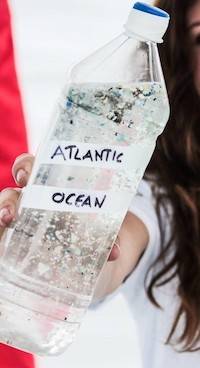Sometimes simple and elegant solutions are all that is needed to solve a problem. One problem that was searching for a solution was how to track microplastics. These small particles of plastics are what results after the sun and friction (such as ocean waves) break down larger plastic objects. They have become a huge problem in the ocean, wreaking havoc on ecosystems and their constituent organisms. Now, a team from the University of Michigan have used data originally collected to monitor hurricanes to try to track microplastics, potentially helping to reign in a problem that threatens to engulf the world's oceans.
The data the team used was collected by NASA's Cyclone Global Navigation Satellite System (CYGNSS). CYGNSS is a constellation of 8 microsatellites that launched in 2016 and normally monitors weather and ocean patterns to keep track of hurricanes. Specifically they were interested in data collected on ocean roughness - or how choppy the ocean is. Though placid oceans are not caused by only a single factor, one factor that contributes to it is the amount of debris in the ocean at a given location.
Heat map from the microplastics tracking paper that shows concentrations of microplastics / low ocean roughness.Credit - University of Michigan Engineering YouTube ChannelMuch of that debris is made up of microplastics. So the researchers theorized that calmer water would result from high concentrations of microplastics. To find the calming effect of those microplastics though, they first had to control for another factor impacting choppiness - wind speed. Luckily, CYGNSS also has data on wind speeds at the same locations it collected data on ocean roughness.
With proper controls in place, the researchers then compared areas of calm seas with the areas of concentrated microplastics, as predicted by models. They matched up particularly well, lending credence to the idea that microplastics could be tracked via remote sensing of ocean roughness.
After completing the basic sanity check of whether their data matched the models, the researchers watched the movements of various microplastic concentrations throughout the world. They noticed some peaks in the size of the Great Pacific Garbage Patch, in June and July, as well as spikes of microplastics at various times around the mouth of the Yangtze River.
The team did not go so far as to actually attempt to sample water at the hotspots identified in the map, but that seems like an obvious next step to prove the modeling they were using for microplastic congregational points was accurate. They are already in talked with an organization called The Ocean Cleanup in order to validate their findings. If the Dutch environmental charity is able to do so, then a potentially catastrophic problem can at least be tracked through data that's already being collected for a completely separate field.
Learn More:
University of Michigan - Ocean microplastics: First global view shows seasonal changes and sources
NASA - Scientists Use NASA Satellite Data to Track Ocean Microplastics From Space
IEEE - Toward the Detection and Imaging of Ocean Microplastics With a Spaceborne Radar
EGU - Imaging Ocean Microplastic Dynamics from Space Using the Cyclone Global Navigation Satellite System (CYGNSS)
UT - NASA’s Experimental Hurricane Monitoring Fleet Launched by Pegasus rocket
Lead Image -
Microplastics collected from the ocean shows how prevalent the problem is.
Credit - NASA
 Universe Today
Universe Today

